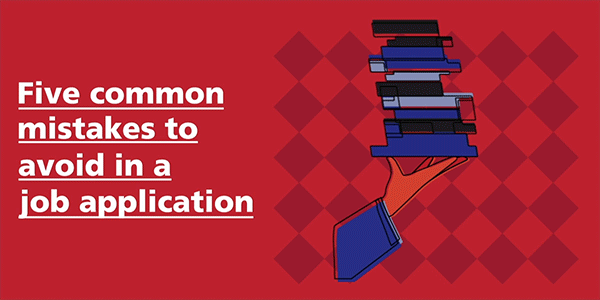Five common mistakes to avoid in a job application

This article was written by freelancer Priyanka Mogul
With summer on the way, many of you might be applying for internships and work experience placements. I remember being at college (and then university) and having very little insight into some of the basic dos and don’ts of job applications.
Fast forward eight years and I’ve now found myself in a position where I’m reviewing CVs for internships at my place of work. As surreal as it is, it’s helped me understand some of the very common mistakes that tend to regularly crop up on applications consistently. Looking back on some of the CVs and cover letters I wrote, I realise that it is very likely I wasn’t shortlisted for an interview because of some of the things I did (or didn’t) put in an application.
To save you (and your potential employers) the hassle, here are a few common mistakes to avoid in a job application – and a few things that could help yours stand out.
1. Your CV and cover letter are not the same thing
Let’s start with the basics, because this is crucial. Your cover letter is not meant to be a longer version of your CV. On average, an employer spends about 60 seconds looking at your cover letter and CV (according to research done by Monster.com, although I’d argue that most of them spend even less than that). So don’t waste their time (and yours) by replicating what has already been said on your CV.
While your CV should list your career history (job titles and organisations), your cover letter should illustrate how your experiences match the job requirements. What specific tasks have you carried out that are similar to what you would be carrying out at the job you are applying for? What responsibilities did you have that show you match the person specifications? What problems did you solve that illustrate you are the right person for the job?
2. It’s a cover letter, not an autobiography
Bearing in mind that an employer spends 60 seconds on your application, you need to keep it brief. Your cover letter isn’t the place for unnecessary personal information, details about skills that are irrelevant to the job you’re applying for, or over explaining why you took a gap year after university.
Read the job specification carefully. Cater to it. Avoid repetition. Your cover letter should generally be no longer than one page (unless you have been told otherwise), and it is definitely the right length for a CV. Keep your CV to one page long or use two pages if you have to include more detail – but never longer than two. I find that, generally, if people avoid the cliches (I’m enthusiastic/determined/willing to work hard), it can bring the word count down on your cover letter significantly. Use your space to sell your experiences – with strong examples and case studies to back up everything you claim to be.
3. Follow instructions
This is so important. Make sure you read job adverts carefully – and follow all the instructions listed in it. Employers will often list things that they want you to include in your cover letter – from larger things relating to your work experience, to smaller things such as when you can start working, your salary expectations, or simply what size font they want the application to be in. Don’t skip over information asked of you. Doing so makes it look as though you don’t pay attention to detail.
On the same note, don’t go over a page when the advert specifically tells you not to. Don’t send your application to a different email address as the one listed in the advert. Don’t email the recruiter asking questions if the answer is already in the advert (please). And, of course, don’t address the organisation by the wrong name (you would be surprised how many times that happens).
And while we’re on the topic of attention to detail, there is no excuse for typos in a job application. Read things over before you press that send button. Do a spell check. Trust me, it will be the difference between getting an interview and an employer reading past the first line.
4. The superfan
This can be a tricky one because employers do want to know why you want to work with them and what makes you a good fit for the organisation. But don’t go overboard with the compliments. Yes, we all have dream jobs and, yes, sometimes we have actually been waiting our entire lives for an opportunity with a specific organisation. But they’ve heard it a million times before.
It is important to illustrate why the organisation is suitable to you, but do this through your interests and experiences, rather than through a bunch of cliche compliments.
5. Embrace the digital age
There are so many great (free) tools out there to help you stand out as an applicant.
Having a digital presence for your career is becoming essential today, and you need to start with your LinkedIn profile. Having the perfect cover letter and CV doesn’t mean you can get away with an incomplete LinkedIn profile. If your employer is someone who prefers a quick LinkedIn search, an out-of-date profile could cost you an interview.
But aside from LinkedIn, make use of sites such as Wix, WordPress and Canva to develop an online portfolio for yourself. Apart from allowing you to showcase the things you have worked on in a visual way, it also gives employers an easy-on-the-eye break from the hundreds of text-based cover letters they have to go through. (Having said that, if the application process specifies that they want a cover letter, do not send an online portfolio instead. Send one as an add-on.)
The digital age is here – and everything is adapting to it, even application processes. While you’re building that online presence, you might want to also start looking into what makes a great video application – a direction more and more employers are heading down these days.
